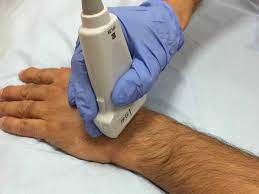Carpal Tunnel Syndrome Hand Therapy
The main cause of carpal tunnel syndrome is constriction or pressure of the median nerve in the middle of the wrist or palm, causing nerve-issues to the thumb, index finger, middle finger and long half of the ring finger (as well as the palm half).
Carpal tunnel syndrome is very common simply because it can (and will) impact anyone who uses their hands a lot. In the United States, around 1 in 20 Americans are diagnosed with it. If it’s severe enough, patients may need a surgery called carpal tunnel release.
Good news is that most of the time, hand therapy can help provide
- pain relief
- tingling or numbness relief
- improve use of hand and fingers
- possibly prevent the need for carpal tunnel release surgery
Contents
What’s Carpal Tunnel Syndrome?

Carpal tunnel image by OpenStax College
Everyone has a carpal tunnel in each wrist, and it’s a very concise tunnel with 8 tendons and 1 nerve (median nerve) that go through the tunnel. The carpal tunnel protects the median nerve and the tendons that bend your wrist and fingers.
Because this carpal tunnel is so concise, any inflammation or swelling can cause strong constriction pressure in all the structures in that tunnel. Tendons are pretty sturdy, so some pressure may not impact them so much…but the nerve, nerves are very sensitive, so even some pressure and constriction can suffocate the nerve.
When the median nerve is pressed and constricted, you may experience:
- pain
- weakness
- tingling, numbness, pins and needles
along the thumb, index finger, middle finger and long half of the ring finger. Includes the palm too. If this pressure is not managed or resolved, it will cause carpal tunnel syndrome.
Causes
Carpal tunnel syndrome is pretty common in work and professions that includes
- assembly-line work such as packing
- work requiring use of hand tools (especially tools that vibrate)
- work that includes a lot of grip and lifting as well as driving
- computer use
Extreme wrist uses as well as wrist positions, as well with lots of finger use can contribute to carpal tunnel syndrome.
Point to note: manual labor and assembly line work is 300% more likely of causing CTS compared to individuals who use computer
Sadly…some hobbies and leisure activities can also cause or aggravate carpal tunnel syndrome, such as
- sewing
- painting
- drawing
- writing
- stitching
- racquet games – badminton, tennis, squash
- string instruments – guitar, violion
…and even the traditional use of chopsticks can aggravate it too.
The following health and medical conditions can also lcause or aggravate carpal tunnel syndromes:
- diabetes
- pregnancy
- steroidal use
- arthritis
- hormonal changes
- injuries to wrist
- post-surgery complications
Signs and Symptoms
CTS usually starts not-very-seriously, and silently, with not very obvious symptoms such as
- some aches
- some tingling or pins and needles
- some numbness
Patients tend to think that “they’re just tired, overworked and need to rest”, and the symptoms DOES improve with rest. They’d “shake” their hands and rest a bit and then continue. Over time, if patient continues the aggravating work, the duration of the symptoms just stretches longer. In the past, the symptoms may disappear overnight, but as it worsens, it may take 2 nights, then 3 then longer and longer.
As carpal tunnel worsens, the symptoms are triggered faster and easier too, even from small stuff, such as
- zipping / unzipping
- lifting up a pot of dish
- picking up coins
- gripping a steering wheel
- cutting fruits
- typing
- carrying grocery bags
- holding onto devices
- etc
Some of our patients report that they drop things right out of their hands without them realizing it as well.
How is CTS diagnosed?
Hand therapists and physiotherapists who suspect you have carpal tunnel syndrome can help diagnose by doing examintations to confirm, such as
- Assessing your shoulder and neck to check if they’re any nerve impingement that’s contributing to the tingling or numbness
- Range of motion
- Grip strength
- Testing sensation and nerves
- Special tests such as Phalen’s and Tinel’s test
Once we suspect carpal tunnel, we may send you to the orthopedic surgeon or neurologist to do
- Electrical studies (electromyogram/EMG) and nerve conduction velocity (NCV) to check nerve function (as well as how bad or severe the carptal tunnel syndrome is)
- X-rays if the patient had trauma or accidents recently, to rule out fractures or dislocations that may contribute to it
- MRI for most clear visualization of the wrist
How hand therapy can help
After the evaluation, we will prescribe your treatment plan based on your specific case.
Non surgery conservative management

If your carpal tunnel syndrome is mild or early stage, most patients will start with hand therapy which may include
- Night and day anti-CTS splinting
- Ergonomic table, chair, mouse, keyboard
- Treatments
- stretching exercises including median nerve glides
- heat therapy such as paraffin wax bath and heat pads
- cold therapy
- ultrasound therapy
- stretching exercises for wrist and median nerve
- anti-vibration gloves or anti-vibration wraps around tool handles, if vibration is a factor at your workplace
The goals of hand therapy are to reduce your carpal tunnel syndrome symptoms and try to prevent carpal tunnel release surgery; as well as to enable you to be as active and functional as possible.
Hand therapy after carpal tunnel release
Most patients may find near-immediate relief of all carpal tunnel symptoms after a carpal tunnel release surgery; and most of the time, hand therapy is fairly quick and straightforward unless the CTS was long standing and there has been some nerve and soft tissue degradation.
For those cases, you may need a prolonged hand therapy management program to build and restore
- wrist and finger strength and movement
- normal sensations as much as possible
- scar management to deal with scarring and scar adhesions (this scar cream may help)
- as well as all mentioned in the above conservative management treatments
Where To Next?
- Go to Home / Start
- Learn and find out more about your pains (bones, muscles, joints, tendons, ligaments, nerves etc) at Pain Conditions & Injuries
- Visit our shop to see products we recommend for pain relief, heating, treatments and more
- Contact us






